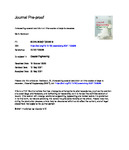Forecasting coastal evolution on time-scales of days to decades
| dc.contributor.author | Mikhalenko, Natalia | |
| dc.date.accessioned | 2021-06-17T10:06:24Z | |
| dc.date.available | 2021-06-17T10:06:24Z | |
| dc.date.issued | 2021-09 | |
| dc.identifier.issn | 0378-3839 | |
| dc.identifier.issn | 1872-7379 | |
| dc.identifier.other | 103928 | |
| dc.identifier.uri | http://hdl.handle.net/10026.1/17261 | |
| dc.description.abstract |
Increasing pressures on coastal environments induced by sea level rise and coastal squeeze has meant that tracking the morphological evolution of sedimentary coasts from the last known survey, pre-empting storm impacts and forecasting potential beach recovery following extreme events is of substantial and increasing societal importance. Equilibrium models for forecasting coastal evolution have figured prominently in the literature in the past two decades and show a strong potential for fulfilling this societal need. In particular some very skilful shoreline evolution models have been proposed based on equilibrium concepts. These models are stable, simple and permit long-term (O(10) years) predictions of coastal change. However, equilibrium models are typically highly empirical and in many cases do not consider explicitly the impact of dynamic sea level, which is modulated by tides, surge and global sea level rise. Equilibrium-based models of shoreline evolution have shown particular promise, but these models generally do not consider the role of the sub- and supra-tidal morphology on coastal evolution (e.g. the importance of coastal dune systems). This contribution presents a new model for Forecasting Coastal Evolution (ForCE), which addresses these issues. The model algorithm adopts a reduced complexity but fundamentally physics-based approach, whilst maintaining equilibrium principles. Unlike, most prior models, the sub- and supra-tidal areas are represented explicitly in the model, as are sea level variations. Sediment transport is equated directly with the disequilibrium in wave energy dissipation flux, leading to a sediment transport formulation that negates the normal intermediate step of computing surfzone currents, generally required in process models. Two components of sediment transport are considered: The first is forced by the turbulent kinetic energy associated with wave breaking and the second diffusive term, is related to a sea bed-slope disequilibrium. The first component perturbs the equilibrium profile and dominates in the surfzone, whilst that latter component plays an important role in beach recovery. Equations are developed for a depth-averaged, beach profile model, assuming longshore uniformity. These computational efficient and stable equations facilitate long forecasts (>decade) and easy comparisons with a field data at cross-shore transport dominated field sites. At the test field site, the model is capable of reproducing qualitative observations of nearshore sand-bar dynamics and quantitative comparisons with measured coastal state indicators including both the shoreline displacement (r = 0.90, N.M.S.E. = 0.145) and intertidal beach volume (r = 0.87). | |
| dc.format.extent | 103928-103928 | |
| dc.language | en | |
| dc.language.iso | en | |
| dc.publisher | Elsevier BV | |
| dc.subject | Prediction | |
| dc.subject | Coastal-evolution | |
| dc.subject | Long-term | |
| dc.subject | Forecasting | |
| dc.subject | Equilibrium | |
| dc.subject | Reduced-complexity | |
| dc.title | Forecasting coastal evolution on time-scales of days to decades | |
| dc.type | journal-article | |
| dc.type | Journal Article | |
| plymouth.author-url | https://www.webofscience.com/api/gateway?GWVersion=2&SrcApp=PARTNER_APP&SrcAuth=LinksAMR&KeyUT=WOS:000677897500003&DestLinkType=FullRecord&DestApp=ALL_WOS&UsrCustomerID=11bb513d99f797142bcfeffcc58ea008 | |
| plymouth.volume | 168 | |
| plymouth.publication-status | Published | |
| plymouth.journal | Coastal Engineering | |
| dc.identifier.doi | 10.1016/j.coastaleng.2021.103928 | |
| plymouth.organisational-group | /Plymouth | |
| plymouth.organisational-group | /Plymouth/Faculty of Science and Engineering | |
| plymouth.organisational-group | /Plymouth/Faculty of Science and Engineering/School of Biological and Marine Sciences | |
| plymouth.organisational-group | /Plymouth/REF 2021 Researchers by UoA | |
| plymouth.organisational-group | /Plymouth/REF 2021 Researchers by UoA/UoA07 Earth Systems and Environmental Sciences | |
| plymouth.organisational-group | /Plymouth/Research Groups | |
| plymouth.organisational-group | /Plymouth/Research Groups/Marine Institute | |
| plymouth.organisational-group | /Plymouth/Users by role | |
| plymouth.organisational-group | /Plymouth/Users by role/Academics | |
| dcterms.dateAccepted | 2021-05-30 | |
| dc.rights.embargodate | 2022-6-10 | |
| dc.identifier.eissn | 1872-7379 | |
| dc.rights.embargoperiod | Not known | |
| rioxxterms.versionofrecord | 10.1016/j.coastaleng.2021.103928 | |
| rioxxterms.licenseref.uri | http://www.rioxx.net/licenses/all-rights-reserved | |
| rioxxterms.licenseref.startdate | 2021-09 | |
| rioxxterms.type | Journal Article/Review | |
| plymouth.funder | Physical and biological dynamic coastal processes and their role in coastal recovery (BLUE-coast)::NERC | |
| plymouth.funder | Physical and biological dynamic coastal processes and their role in coastal recovery (BLUE-coast)::NERC |


